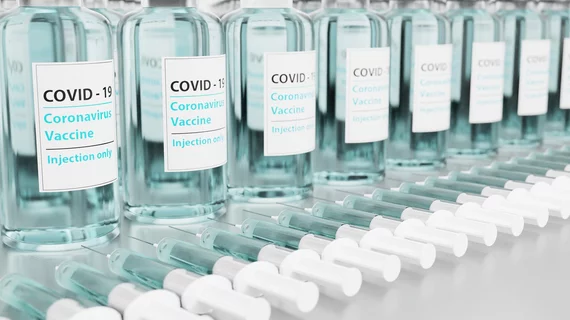FDG PET/CT radiomics distinguishes between vaccine-related or metastatic breast cancer lymphadenopathy
FDG PET/CT radiomics can differentiate between COVID vaccine-related adenopathy and swelling in the lymph nodes due to breast cancer metastases.
European Radiology recently reported that radiomics features were able to identify statistically significant differences in the PET/CT imaging of women with pathologically confirmed metastatic breast cancer and women who had experienced axillary lymphadenopathy after receiving a COVID vaccine. The performance was tested using 110 features extracted from the imaging of 99 women. The findings could help clinicians manage patient treatment when the origin of lymphadenopathy is of concern, experts suggested.
“The presence of ipsilateral fluorodeoxyglucose (FDG)-avid axillary lymph nodes after COVID-19 mRNA vaccination might challenge study interpretation, specifically in malignancies with a tendency to involve the axilla, of which breast cancer is the most common in women,” corresponding author Michal Eifer, from the Department of Diagnostic Imaging at Chaim Sheba Medical Center in Ramat Gan, Israel, and co-authors explained. “As FDG PET/CT cannot always be postponed, and must sometimes be conducted in proximity to the administration of the COVID-19 mRNA vaccine (e.g., in case of acute symptoms or urgent treatment planning), there is an unmet need to develop objective variables to identify COVID-19 mRNA vaccine–associated FDG-avid lymph nodes.”
Since the widespread distribution of COVID vaccines began, vaccine-related lymphadenopathy has been a hindrance in the medical field. Distinguishing between lymph node swelling that is the result of an mRNA vaccine and that which could be due to the spread of cancer can be challenging. Radiomics is beneficial in these scenarios, as it can extract image features that radiologists may be unable to visualize themselves. This detects patterns based on the size, texture and heterogeneity of tumors and/or lymph nodes, which can help experts establish whether pathology has a benign or malignant origin.
Researchers recently found that radiomics and machine learning are especially valuable when distinguishing the root cause of FDG-avid metastatic axillary lymphadenopathy in breast cancer patients and FDG-avid reactive axillary lymphadenopathy. Using 110 extracted features from the FDG PET/CT scans of 99 women (46 vaccinated patients and 53 breast cancer patients), experts found significant differences between radiomics features and all combined PET/CT features. This resulted in .98 validation AUC and 96% validation accuracy, the experts noted.
While these results confirm the researchers’ hypothesis that radiomics and machine learning could play an important role in differentiating lymphadenopathy origins, they caution that their sample size was small, and that additional research is necessary to confirm their findings.
“Further larger studies are needed to validate these results and to evaluate if this method can also be applied to differentiate benign lymphadenopathy from a malignant one in other conditions where the clinical assessment is not so helpful,” the authors concluded.
The detailed research can be viewed in European Radiology.
More on COVID in medical imaging:
Intrathoracic complications in COVID patients: Incidence, associations and outcomes
Specialized CT protocol reveals small airways disease in COVID long haulers
These ultrasound features distinguish between COVID vaccine-related and malignant adenopathy
VIDEO: Should women wait to get mammograms after COVID vaccination?
'Pandemic brain': PET/MRI images reveal how COVID's impact is felt by non-infected individuals

